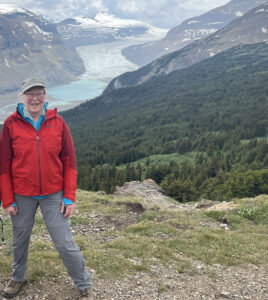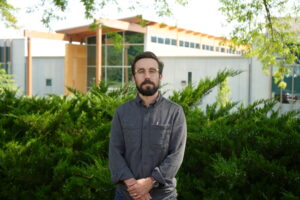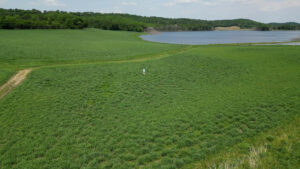Investigating private well water contamination in southwest Wisconsin
March 6, 2024
By Jenna Mertz
A WRI-funded study is determining the health risk of pathogens found in private wells in southwestern Wisconsin. The research builds upon the findings of the Southwest Wisconsin Groundwater and Geology (SWIGG) project, which found livestock manure and human wastewater in private well water from Grant, Iowa and Lafayette counties in 2018 and 2019.
The new research will also shed light on the relationship between groundwater, human and livestock waste, and antibiotic resistance.

Maureen Muldoon, a hydrogeologist with the Wisconsin Geological and Natural History Survey, is leading the study. Having previously worked on the SWIGG study, she’s now investigating how local geology and well construction influence the contamination of private wells.
She says wells in the southwestern part of Wisconsin are particularly vulnerable to contamination due to fractured bedrock, which has a lot of holes and cracks.
“When you drive down Highway 151 towards Iowa and you look on the sides of the road and it just looks like Swiss cheese, kind of yellowy-brown Swiss cheese, that is [fractured bedrock],” said Muldoon. “You can imagine how quickly stuff moves through that.”
This porous, Swiss cheese-like bedrock means wastewater from septic systems and agriculture can quickly enter the aquifer, carrying pathogens that can end up in private wells. The SWIGG study found viral, bacterial and protozoan pathogens in 66 of 138 private wells sampled, including norovirus, salmonella, and multiple species of Cryptosporidium.
Just how many people could get sick from these pathogens is what Tucker Burch, a research engineer with the U.S. Department of Agriculture, is trying to figure out. Using archived water samples collected during SWIGG, Burch can estimate the risk of gastrointestinal illness using a tool called quantitative microbial risk assessment, or QMRA. He likened it to a weather report.
“It’s a forecasting method; it’s a modeling approach,” said Burch. “We’re using the data we have to make an estimate about what’s going to happen.”

In addition to determining the public’s risk of gastrointestinal illness, Burch and the research team will identify whether pathogens came from human or livestock waste in the upper or lower parts of the aquifer.
Muldoon said well location matters when it comes to water quality. The lower aquifer is generally more protected from contaminants than the upper aquifer due to a layer of rock that restricts the downward flow of water. Certain types of well construction, however, allow water to pass through to the lower aquifer.
“It is not good to connect the upper and lower aquifer in this environment because we are exporting water quality problems to the deep, relatively protected aquifer,” said Muldoon. She is currently gathering and analyzing construction reports for the 138 wells used in the study.
In addition to microbes that cause gastrointestinal illness, the research team is also testing the water for antibiotic resistance genes (ARGs) to learn more about where they come from. ARGs are the building blocks of antibiotic resistance.
“Antibiotic resistance, like any other biological trait, is mitigated by genes,” said Burch. “So bacteria have specific genes that give them different mechanisms to fight the antibiotics.”
Joel Stokdyk, a biologist with the U.S. Geological Survey leading the research team’s inquiry into ARGs, emphasizes that the study isn’t delving into the impacts of ARGs on human health or antibiotic resistant infections.

“A point worth making is that the detection of the antibiotic resistance gene in someone’s drinking water does not mean it’s in a pathogen, does not mean it could make them sick, but it does help us address these other questions.”
One of those questions concerns how many ARGs come from humans versus livestock. Stokdyk said that’s what makes this research novel.
“The research field knows antibiotic resistance genes come from these sources, but we don’t know how much from each. So that’s one of the gaps we’re trying to address,” said Stokdyk.
Although the research team is currently in the data collection and lab phase of the study, they’re already excited about the results. Knowing the amount and source of ARGs could help tailor current manure management strategies and shape future research in livestock production or human medicine.
Said Burch, “There [are] people out there in the real world that take these results and turn around and use them. And that’s always very satisfying. We’re not just running numbers across a computer screen.”
The post Investigating private well water contamination in southwest Wisconsin first appeared on WRI.News Release | WRI
https://www.wri.wisc.edu/news/investigating-private-well-water-contamination-in-southwest-wisconsin/

